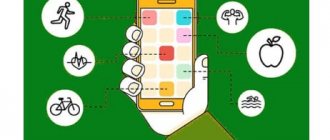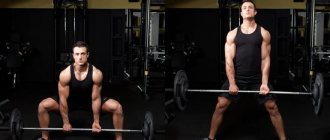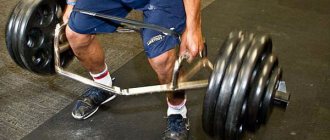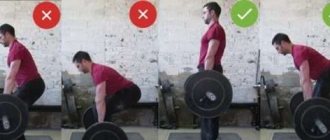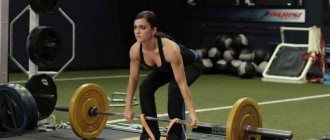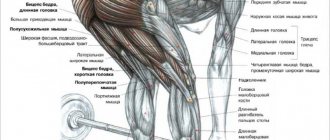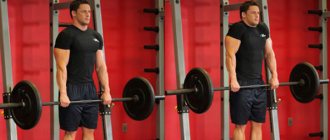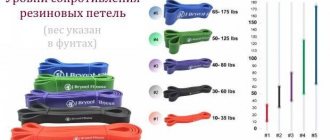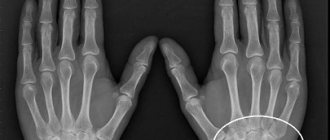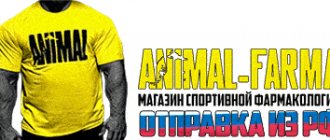| Deadlift | |
| Classification | |
| Type | Basic |
| Biomechanics | Multi-joint |
| Direction | Traction |
| Working muscles | |
| Target | spinal erectors femoral biceps adductor muscles of the thigh gluteal muscles trapezius muscle deltoid muscle of the forearm biceps of the arms |
Procedure for performing deadlifts
phase 1
phase 2
phase 3
Deadlift
- a basic (multi-joint) exercise, usually performed with a barbell, as well as a dumbbell or kettlebell, held between the legs with both hands. It is used as a general element of physical training and is one of the competitive disciplines in sports such as powerlifting and extreme strength; it is also used by bodybuilders to strengthen the lower back muscles, which allows them to better develop their legs in squats.
What is a deadlift?
What kind of exercise is the deadlift? In short, it is lifting a barbell (or other weight) from the floor, performed by working the muscles of the legs and back. This exercise is excellent for gaining muscle mass and increasing strength, since here we can work with serious weights, while using almost all muscle groups of our body. The deadlift is rightfully considered a classic basic exercise, which no athlete can exclude from his program.
Beginners, as well as experienced athletes, are strongly recommended to begin deadlift training with a thorough warm-up and stretching. The movement must be powerful and synchronous, each muscle must be involved in the work exactly when necessary, and it is unlikely that it will be possible to perform a deadlift technically correctly without properly preparing our muscles and joint-ligamentous apparatus for heavy power work.
There are 3 main types of deadlifts: classic, sumo and Romanian. Each of them is complemented by a different variation of weights (barbell, kettlebell, dumbbells, Smith machine, trap bar, etc.) We will talk about each type separately.
The difference between them lies in the position of the arms and legs, due to which the load falls more on the back or legs. There are also several additional types of this exercise that are of no less interest to us, for example:
- deadlift on straight legs (Romanian deadlift);
- deadlift in the Smith machine;
- deadlift with trap bar;
- deadlift with dumbbells.
We will look at each of these types in more detail in this article.
Muscles[ | ]
When performing deadlifts, almost 3/4 of the entire muscle mass is involved, primarily these are: back extensors, buttocks, quadriceps and biceps femoris, latissimus dorsi, trapezius, posterior deltoids, forearms and biceps. Deadlift on straight legs, so-called. “Romanian deadlift” additionally stretches and loads the hamstrings, forcing them to work to the limit in dynamic tension, as well as the upper lobes of the buttocks; The weights used in this type of deadlift are moderate, less than in the deadlift [1]. That is why, by performing different variations of deadlifts, athletes gain the most muscle mass and therefore this exercise is considered a basic one.[2]
https://youtu.be/7jGNBf0HuDU
Deadlift Equipment
A conversation about deadlift would be incomplete without mentioning the current records in this movement. Deadlifts can be performed without equipment or with equipment. The question arises: what can be considered equipment? Overalls? Straps? Or even a belt? We share the most conservative position on this issue, namely: equipment is what increases your results, so straps, overalls and knee bandages can safely be classified as equipment division.
The belt is a slightly different story. Of course, an athletic belt helps lift slightly more weight when performing deadlifts, but its primary function is to protect you from the occurrence of an umbilical hernia or lower back injuries, so its use is acceptable and often even necessary in raw powerlifting, and this does not contradict the rules of the federations. There are no more unique people like Konstantin Konstantinov, who are able to lift more than 400 kg without a belt, in the whole world, so it is better to take care of your overall health in advance and not neglect the use of a belt. Portal cross.expert – for safe sports.
Safety
Incorrect technique may cause injury or recall existing injuries; The greater the weight lifted, the greater the danger. If you round your back rather than keep it straight (with some arching), then the load on the intervertebral discs becomes uneven, which can cause displacement of the vertebrae. This especially applies to the lumbar spine, which receives the main load when performing deadlifts. In addition, uneven load on the intervertebral disc can cause pinching of the spinal nerves.
Most athletes use special weightlifting or powerlifting belts to stabilize their lower back. However, it should be remembered that the belt does not directly hold the vertebrae, but contributes to an increase in intra-abdominal pressure by the fact that the belt presses on the athlete’s stomach and prevents it from protruding. When performing deadlifts without a belt, an increase in intra-abdominal pressure is achieved by tensing the abdominal muscles by retracting them.
Using a grip, when the thumbs are turned to the sides and then the fingers from below clasp the bar, is also, in principle, dangerous when lifting very heavy weights. The curl shortens the biceps and increases stress on it, which can lead to tearing of the biceps or the tendons connected to it. This risk is especially increased if there is no full flexibility in the elbow joint.
The mixed grip, despite its popularity among powerlifters, is also potentially dangerous. It helps create a torque around the axis of the spine, which, compared to a straight grip, significantly increases the possibility of injury to the latter (especially when working with heavy weights, with repeated approaches and with problems with the spine). To minimize the influence of torque, the rotation of the hands should be changed after each approach. If you have a weak grip in amateur sports, preference should be given to using wrist straps or loops rather than using a different grip.
The use of equipment by athletes - straps, loops, belts, hooks - helps to hold the barbell, which significantly reduces the load on the forearm muscles and allows you to concentrate on the pull itself, and not on holding it.
To avoid injury to the lumbar region, it is recommended to do deadlifts after complete recovery, which usually lasts at least 7-10 days. You should also warm up thoroughly with light weights and do not neglect safety precautions.
Deadlift records
One way or another, the current absolute record in deadlift belongs to Icelander Benedikt Magnusson (weight category over 140 kg). He conquered 460 kg. There are two more equally impressive records, but they were performed using straps and overalls. However, this does not detract from their importance:
- Briton Eddie Hall conquered 500 kg (weight category over 140 kg), watch the epic video of this event below;
- Russian Yuri Belkin won 450 kg (ATTENTION, weight category up to 110 kg).
Which of these is more significant for the development of sports as a whole and setting the right example for novice athletes, decide for yourself. My opinion is the following: Belkin’s result is simply space. We wish the athlete to set new world records and avoid injuries.
Mistake 3: Bicep curls while deadlifting
Any healthy man under the age of 50 (provided there are no injuries) after two years of regular training will be able to deadlift 140 kg. And no one on earth can perform a biceps curl with such a weight. In short, you won't be able to deadlift much weight if you try to do the exercise with your arms bent and a "biceps curl." Believe it or not, the most common deadlift injury is a torn biceps! Fortunately, it is easy to prevent: do not pull the barbell with bent arms.
If you deadlift with bent elbows, the bar will make the necessary correction for you and force you to straighten your arms. At best it will be pain in the elbow joint; at worst, you end up seeing a local trauma surgeon because of a torn biceps.
The solution is simple - pull the projectile with fully straightened arms. This is not only safe, but also reduces the range of motion of the barbell. As my brother, Noah Bryant, always says, “Your hands are ropes and your palms are hooks. Lock your elbows during the deadlift."
Your arms should be straight throughout the movement. If they are bent, you risk injuring your biceps
Types and technique of execution
Next we will dwell in detail on the types of deadlifts, of which there are much more than an inexperienced athlete might think. Let's start, of course, with the classic version.
Classic deadlift
The classic version of the deadlift is perhaps the most common in crossfit, extreme strength training and powerlifting. There is no exact information about what sports discipline it originated in, but most likely it was weightlifting - the first part of the push represents precisely this movement.
So, how to do deadlifts correctly step by step (execution technique):
- With a classic deadlift, the athlete grabs the bar shoulder-width apart, his legs are slightly narrower, and his feet are parallel to each other.
- The bar of the barbell is pushed as close as possible to the shins, so it is recommended to use gaiters when performing deadlifts.
- The shoulder blades and shoulders are pulled back slightly.
- The movement begins with the movement of the legs - the bar must be “torn off” with the force of the quadriceps and buttocks. When the bar has passed 20-30% of the amplitude, the athlete should begin moving with his back, fully straighten at the waist and lock in the final position.
A short video with the deadlift technique:
Most of the load in the classic deadlift falls on the back muscles (namely, the spinal extensors and trapezius muscles), so this option is recommended for athletes whose back muscles predominate over the leg muscles. There are also a number of anatomical features of the body’s structure (for example, long arms or a short torso), in which it is worth performing classic deadlifts.
The main mistake beginners make here is rounding their back when lifting (hump row). By doing this, you risk getting a serious back injury and forgetting about athletic longevity.
Pay careful attention to practicing the correct exercise technique so you can get the most out of this movement.
Detailed video about the correct execution of the classic deadlift, analysis of typical mistakes of beginners:
Sumo deadlift
With a sumo deadlift, the load shifts more to the quadriceps and hip adductors. The latissimus dorsi, spinal extensors and abdominal muscles bear more of a static load, since extension in the lumbar region is much less than in the classic version.
When doing sumo deadlifts, the athlete grabs the bar slightly narrower than shoulder level, and, on the contrary, places his legs wider. How wide depends on the level of stretch. It is clear that the wider the legs are, the shorter the amplitude will be, and, therefore, the higher the result will be, however, if you do not have sufficient stretching, if you place your legs too wide, you risk getting a sprain or tear of the adductor muscles. Therefore, it is recommended to start with a medium foot position (slightly wider than shoulder width) and gradually increase it, while not forgetting to pay special attention to stretching.
The movement in the lower back during the sumo deadlift is minimal; we do not need to “bend” with the barbell, as with the classic version. We need to lift it with maximum effort from the leg muscles, without rounding the back or leaning forward.
The most common mistake beginners make when performing sumo deadlifts is moving too much in the back. At the lowest point, they lean over the barbell and tear it off with the simultaneous effort of their back and legs. This is fundamentally wrong: when doing sumo deadlifts, we engage our backs only in the upper part of the amplitude (approximately the last 20% of the movement), working with serious weights. If it is more convenient for you to transfer part of the load to the lower back, it is better to perform deadlifts in the classic version, pay sufficient attention to developing the technique, and personal records will not take long to arrive.
The sumo deadlift is more suitable for athletes with well-developed legs and buttocks. Great for athletes with long torsos and short arms.
Deadlift on straight legs (Romanian deadlift)
The Romanian deadlift has nothing in common with powerlifting, but is an excellent isolation exercise for developing the glutes and hamstrings. The movement is performed on straight legs and with a fixed back by moving the buttocks back. Working in such an amplitude, the biceps of the thigh stretches perfectly in the positive phase of the movement and contracts in the negative phase.
In this exercise, the neuromuscular connection is primary, and not the weight being lifted, so I do not recommend performing straight-legged deadlifts with heavy weights unless you feel an accentuated load on the desired muscle groups. In addition, when working with heavy weights, there is a risk of damaging the hamstrings, which stretch as the pelvis moves back. This can stop your progress in the squat and deadlift as it will take at least a few weeks to recover.
Smith machine deadlift
This is not the most common exercise, however, it has obvious advantages. The Smith machine gives us the opportunity to work along a trajectory specified by the joints, so it is easier for us to focus on the biomechanics of movement and “catch” the contraction of the desired muscles.
In addition, in Smith it is very convenient to set the limiters to the desired level and work due to this in a shortened amplitude (performing some kind of traction from the plinths). A shorter range of motion allows us to get used to working with heavier weights, improves grip strength, and prepares a good foundation for increasing strength in the deadlift and other basic exercises.
Deadlift with trap bar
If your gym is equipped with a trap bar, rejoice! In Russia this is very rare, but in vain, because this bar allows us to work in a slightly different amplitude and increase our strength indicators. The trap bar has the shape of a diamond, inside of which there are handles for gripping. The palms are parallel to each other, and the handles themselves are at the level of the body, making it much easier to keep your back straight throughout the lift, which many people lack when performing classic deadlifts.
Here is a detailed description of the technique for performing deadlifts with a trap bar.
Deadlift with dumbbells
An obvious advantage in working with dumbbells is a longer amplitude, since the dumbbell bar will be located below the barbell bar. Therefore, deadlifts with dumbbells have a place in the training process of a CrossFit athlete, since it is convenient to combine them with dumbbell push-ups or thrusters.
In addition to the semblance of the classic deadlift, there is an exercise called “plie squats”, which is popular among many girls who are interested in fitness. The movement is similar to a sumo-style deadlift, however we do not place dumbbells on the floor and work without stopping in the top position in a shortened amplitude, keeping the hip adductors in constant tension. The back should be kept straight throughout the entire exercise, the weight of the weight is selected individually, but it should be borne in mind that in such isolated exercises there is practically no point in working less than 10-15 repetitions. Here we work on target muscle groups, and do not set strength records.
Bar grip and grip strength[ | ]
Grip of the bar during sumo deadlifts
When performing heavy weight deadlifts, your hands may not be able to withstand the load and become loose. Therefore, athletes resort to various methods: they use special types of grips, use auxiliary equipment (straps, hooks, etc.), use exercise options to develop the muscles of the forearms and, accordingly, strengthen the grip.
The most convenient grip for performing deadlifts is the so-called “mixed grip” (or “mixed grip”), when the thumbs are not directed towards each other, but look in the same direction, that is, one is turned outward, and the other inward. This grip prevents the bar from slipping out of your hands, but creates a torque on the spine, and can lead to the development of scoliosis and injuries due to uneven load, therefore it is most often used by professionals to lift maximum weights.
The “direct grip” is the most convenient and practiced; it is what professionals recommend to amateurs and beginners. A direct grip in the deadlift exercise without the use of straps or hooks allows you to maximally load the athlete’s forearms, which increases grip strength, and this in turn is a very important factor in the new official sport - armlifting, and also allows you to easily switch to free weights (kettlebells, dumbbells , harnesses and other sports equipment) in further training.[3] It is necessary to distinguish between “direct” and “straight” grip. If both hands are in the same position relative to the bar, it is a grip of the same name. The direct grip is of the same name, as is the reverse grip.
There is also a lock grip or a weightlifter grip. The difference from a straight grip is that the thumbs do not clasp the bar, but are sandwiched between the bar and the rest of the fingers. It has long been used in weightlifting, but has a significant drawback - pain in the thumbs, so it is rarely used in auxiliary exercises, more often using straps.
To develop the holding power of the hands, athletes perform an auxiliary exercise - deadlifts with holding; plinth is a wooden cube measuring 40x40x10, usually covered with rubber. The hold is performed with a direct grip, so the grip strength is worked out most optimally, and the load on the spine is reduced due to the inability to lift the maximum weight, which professionals usually use with a different grip. After performing the deadlift, the weight is reduced by 30-40%, the sports equipment is lifted from the plinths and held for as long as possible, usually 20-30 seconds, and the barbell is lowered onto the plinths. This is how 2-3 or more approaches are performed.[4]
Deadlift Standards
Separate deadlift competitions are held under the auspices of all powerlifting federations operating in Russia (FPR, WPC/AWPC, ASM “Vityaz”, etc.). At the same time, there is no distinction as to what style the athlete should pull in: sumo or classic. For many athletes, this moment causes indignation, some demand the introduction of a separate division for sumo deadlifting, some demand that sumo deadlifting be completely banned, and existing records invalidated, or the creation of a separate federation where everyone will lift in sumo... These statements are heard, in my opinion, it is simply absurd. The rules of the federation do not regulate any type of deadlift as the only correct one, and each athlete has the right to choose the style in which he is able to show the greatest results, at his own discretion.
Below are the standards for deadlifts for men, approved by probably the most popular federation among amateur athletes - AWPC (doping control division). The standards of this federation for deadlift are quite democratic, so it will not be too difficult for any more or less prepared athlete to prepare for some regional competitions and first complete the first adult category. And then - more. Therefore, if you have already achieved certain results in the deadlift, try to confirm them in competitions. An adrenaline rush and an unforgettable experience are guaranteed.
Rating standards for men's deadlift without equipment (AWPC):
| Weight category | Elite | MSMK | MS | KMS | I category | II category | III category | I junior | II junior |
| 52 | 197,5 | 175 | 152,5 | 132,5 | 115 | 105 | 90 | 75 | 60 |
| 56 | 212,5 | 187,5 | 162,5 | 142,5 | 125 | 115 | 97,5 | 82,5 | 65 |
| 60 | 225 | 200 | 172,5 | 150 | 132,5 | 120 | 105 | 87,5 | 70 |
| 67,5 | 247,5 | 217,5 | 190 | 165 | 145 | 132,5 | 112,5 | 95 | 75 |
| 75 | 265 | 232,5 | 202,5 | 177,5 | 155 | 142,5 | 122,5 | 102,5 | 80 |
| 82,5 | 277,5 | 245 | 215 | 185 | 162,5 | 150 | 127,5 | 107,5 | 85 |
| 90 | 290 | 255 | 222,5 | 195 | 170 | 155 | 132,5 | 112,5 | 90 |
| 100 | 302,5 | 267,5 | 232,5 | 202,5 | 177,5 | 162,5 | 140 | 115 | 92,5 |
| 110 | 312,5 | 275 | 240 | 207,5 | 182,5 | 167,5 | 145 | 120 | 95 |
| 125 | 322,5 | 285 | 247,5 | 215 | 190 | 175 | 150 | 125 | 100 |
| 140 | 332,5 | 292,5 | 255 | 222,5 | 192,5 | 177,2 | 152,5 | 127,5 | 102,5 |
| 140+ | 337,5 | 300 | 260 | 225 | 197,5 | 182,2 | 155 | 130 | 105 |
You can download and print the table if necessary using the link.
For women:
| Weight category | Elite | MSMK | MS | KMS | I category | II category | III category | I junior | II junior |
| 44 | 127,5 | 115 | 100 | 85 | 75 | 70 | 60 | 50 | 40 |
| 48 | 140 | 122,5 | 107,5 | 92,5 | 82,5 | 75 | 65 | 52,5 | 42,5 |
| 52 | 150 | 132,5 | 115 | 100 | 87,5 | 80 | 70 | 57,5 | 45 |
| 56 | 157,5 | 140 | 122,5 | 105 | 92,5 | 85 | 72,5 | 60 | 47,5 |
| 60 | 165 | 147,5 | 127,5 | 110 | 97,5 | 90 | 77,5 | 62,5 | 50 |
| 67,5 | 177,5 | 157,5 | 135 | 117,5 | 102,5 | 95 | 82,5 | 67,5 | 55 |
| 75 | 185 | 165 | 142,5 | 125 | 110 | 100 | 85 | 72,5 | 57,5 |
| 82,5 | 192,5 | 170 | 150 | 130 | 112,5 | 105 | 90 | 75 | 60 |
| 90 | 200 | 177,5 | 152,5 | 132,5 | 117,5 | 107,5 | 92,5 | 77,5 | 62,5 |
| 90+ | 202,5 | 180 | 155 | 135 | 120 | 110 | 95 | 80 | 65 |
You can download and print the table if necessary using the link.
Alternative Deadlift Exercises
What can replace deadlifts? I’ll say right away that the following information is intended for those athletes who cannot perform deadlifts due to medical contraindications, but want to work target muscle groups using other exercises.
For everyone else, the answer is: NOTHING.
The deadlift is a multi-joint exercise that uses almost all the muscles in our body. And the effect it has on our strength and muscle mass can hardly be replaced by hyperextensions, barbell bends, or exercises for the hip adductors. Therefore, if you cannot perform deadlifts because axial load on the spine is contraindicated for you, include the following exercises in your training process:
- Pull-ups on the bar – probably the best exercise in the world for gaining back muscle mass and creating a V-shaped silhouette. It is important to try to carry out the movement by contracting the latissimus muscles, bringing and spreading the shoulder blades, while minimally including the forearms and biceps. This way you will get maximum efficiency from this exercise. Perform other lat exercises where the axial load is minimal (wide-grip vertical pull-down, close-grip horizontal pull-down, overhead pullover, hummer row, etc.) in order to put more stress on the muscles and create the preconditions for growth of muscle mass.
© Makatserchyk — stock.adobe.com
- Hyperextension – an exercise that perfectly develops the main muscle group that works during the classic deadlift – the spinal extensors. It is noteworthy in that the axial load in it is practically zero, therefore it is strongly recommended to be performed not only as an alternative to the deadlift, but also as an addition to it, and as a general strengthening preventive exercise, and as an exercise aimed at rehabilitating an injured lower back.
© Makatserchyk — stock.adobe.com
- Reverse hyperextensions – a type of hyperextension where the athlete contracts the target muscle group by lifting the legs rather than the body. The load here is more directed at the lower part of the spinal extensors; the sacrum area receives the maximum blood flow.
- Advances and flyes while sitting in the simulator – exercises with which you can separately load the adductor muscles of the thigh and buttocks without axial load on the spine. Therefore, if the sumo deadlift is contraindicated for you, you may well include these two exercises in your arsenal.
© Makatserchyk — stock.adobe.com
Features of deadlift
This technique is rarely used under normal conditions and is more relevant for girls. Professional bodybuilders also use it, because it has a great effect on the back of the thigh. In addition to the biceps, the exercise has a positive effect on the buttocks and lower back muscles.
The peculiarity of the technique is the prohibition of excessive weight. The pursuit of significant indicators in this regard inevitably leads to injury. We can’t set records here; we leave them for other modifications of the deadlift.
The deadlift technique is different; the main difference is straight legs. Yes, there is no need to bend your knees here, if only a little due to the anatomical features of the body. It is also advisable that the bar be on racks and not on the floor.
- The stance is similar to the classic one (legs are shoulder-width apart and feet are parallel).
- The grip is similar to the classic one (from above, shoulder width apart).
- Bend your elbows (a little) and keep your back straight, as if it were fixed at the back by planks. The shoulder blades must be brought together throughout the entire process of lifting weights.
- Already moving down, we arch our backs and bend over, moving our pelvis back (synchronously). Be sure to keep your shoulder blades brought together, and your back always remains arched. You cannot round your back at the very bottom; you should feel the maximum stretch in the muscles located on the back of the thigh. There is no need to straighten your arms, your knees are slightly bent. Lower the bar to the middle of the shin.
- Climb. The barbell rises only due to the tension of the hamstrings. You need to lift the projectile no higher than the middle of your thigh, and the bar moves upward along your shins. It is important to start lifting without jerking, and the secret lies in lifting correctly. It needs to be implemented not with the back muscles, but with the legs. Your feet should be firmly planted on the floor and your legs should be pushing the weight upward. Then your back will not get tired, and the effect will be maximum.
- The gaze is always directed forward during the exercise.
- The bar moves exclusively vertically along the legs; there should be no deviations.
Deadlifts are often performed not with a barbell, but with dumbbells.
How to improve your deadlift strength?
Your performance in a deadlift, whether classic or sumo, depends on two aspects:
- the acceleration you give to the barbell;
- maintaining proper technique on maximum weights
Boom acceleration
The greater the acceleration you set when breaking the bar, the easier it will be for you to complete the movement. Therefore, it is necessary to pay special attention to the explosive strength of the legs and back and you should include the following exercises in your training process that will help you make deadlifts more explosive and faster:
- Squats with a pause at the bottom;
- Jumping on a box;
- Standing up with a barbell from a squat position;
- Squats with a barbell on a bench;
- Snatch pull-ups.
- Deadlift paused at knee level.
Correct technique
As for the correct technique, it is purely a matter of time and experience. It is necessary to separately practice deadlifts in full, shortened and extended amplitudes.
Working in a shortened amplitude (pull from the plinths) , we can perform the exercise with a large weight, shifting the load on the entire array of back muscles. In addition, we develop grip strength and psychologically get used to maximum weights.
When working in an extended amplitude (pull from the pit) , we work with a slightly lighter weight, but we perform the movement, emphasizing the load in the quadriceps. This will inexorably lead to an increase in strength indicators in the deadlift to full amplitude, since deadlifting from the pit, of course, will be more difficult both physically and psychologically.
In addition, there are several other conditions for good traction.
The first of these is stretching. This is especially important for those athletes who perform sumo-style deadlifts. It is necessary to pay special attention to the fascia of the adductor muscles of the thigh and quadriceps - they should be elastic and mobile, perform the variations of the splits that are most convenient for your structure. This way you will protect yourself from possible injuries and will be able to work at an optimal amplitude without experiencing discomfort or pain in the muscles and tendons.
Don’t forget about stretching the torso, perform various exercises aimed at stretching the lats, chest, lower back or abdominals, from different angles, not a single muscle in your body should be “wooden”, then the deadlift will become comfortable and absolutely natural for you from the point of view of anatomy and biomechanics of movement.
Equally important is isolated work on the target muscle groups working during deadlifting. For example, you should perform pull-ups, bent-over barbell or dumbbell rows, hyperextensions, and boat lifts to keep your back muscles ready for strength work. Don't forget about our "foundation". Additionally, strengthen your leg muscles by doing barbell squats, leg presses, seated extensions and other exercises for the quadriceps and hamstrings.
Working on weak points
To avoid flaws in technique that arise due to problems in a certain part of the amplitude, you need to separately work on weak points. To work out the upper part of the amplitude, many people use traction from plinths (small elevation). However, Yuri Belkin states that problems with the upper part of the amplitude are most likely caused by gaps in technique, so it is better to simply reduce the weight and more closely monitor the correct execution of the movement.
If you have problems with the bar falling off, you can use the so-called pit row. In fact, you don’t need any pit here, you just stand on an elevation of 5-10 centimeters and perform an extended version of the deadlift.
